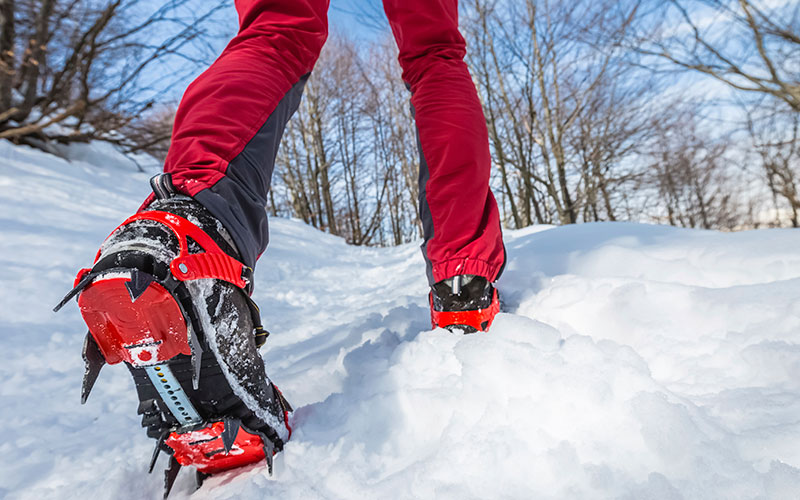You can strap a lot of different gear to your feet for winter adventure. But do you really need to?
There are obvious benefits to avoiding the hassle and weight of equipment like snowshoes, gaiters, and crampons—so here’s my advice for evaluating whether you need them in the first place.


Classic 10-point crampons help you tackle ice and hard-packed snow, but aren’t usually necessary for more moderate conditions like those pictured here.
For this exercise, I’m going to assume that the terrain around you contains some amount of snow and ice that you’ll need to navigate. So first questions: Are you on a snow-covered trail that has been packed down by many winter hikers before you? Can you sink your boots into the snow an inch or two but not much more? And is the terrain moderate enough that you have sufficient traction with just your boot treads? You don’t need snowshoes, gaiters, or crampons. (These are common conditions on many popular winter trails in the Northeast, especially if there has been a decent period since the last significant snowfall.)
Now let’s throw in some variations. Are you dealing with unbroken (or mostly unbroken) snow-covered terrain where your boots are sinking in over the ankle tops? You are now in snowshoe and gaiter country—the snowshoes to reduce the amount you sink, the gaiters to keep snow out of your boots.
If you encounter these conditions only briefly on your hike, you can likely get away without using snowshoes but should take steps to protect your boot tops. If your snow pants have an elastic seal in the cuffs that goes over your boots, you should be OK. Otherwise put on some gaiters. If these conditions are common throughout your hike, don snowshoes and gaiters for the duration.
Last round of questions: Are you traveling over ice or hard-packed snow that your boots can’t penetrate? Is the terrain steep and slippery? Time to put on some crampons to dig into the snow and ice and provide maximum traction underfoot. For moderate terrain, you can get away with a lighter-weight pair of crampons (such as the Kahtoola Microspikes or Hillsound Trail Crampons). If you’re tackling steeper, more challenging conditions, however, you’ll want the longer points and more secure fit of full crampons. You’ll also want to wear a pair of tough gaiters to protect your lower pants and boots from the sharp crampon points, which you will inevitably snag on your clothing.
Snowshoes can also work if you only occasionally encounter these conditions on the hike, though you’ll want a model that features substantial traction underfoot to ensure an adequate grip.
Enjoy your winter adventures!